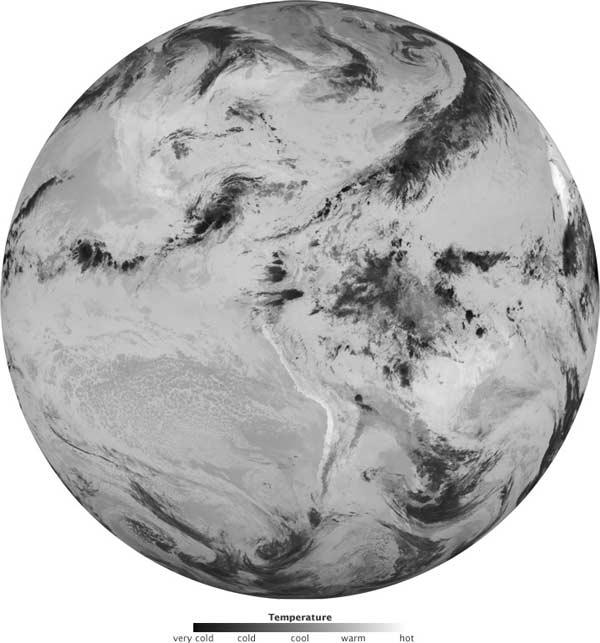
Taking the Temperature of Clouds

The role that Earth's clouds play in influencing the processes that are causing the planet to warm is one of the bigger unknowns in global warming science, though scientists are continually using new methods including research based on satellite images to try and tease out that role.
In a new image from NASA's GOES Earth-observing satellite, the temperatures of clouds over the Western Hemisphere are shown, which in turn can be an indicator of the potential of these clouds to contribute to or mitigate global warming .
The warmest areas in the image and therefore emitting the most thermal energy are white and pale gray. The desert lining the Pacific coast of South America is a bright white strip in the lower center of the globe. The coldest regions those emitting the least amount of thermal energy are dark gray and black. These dark spots on the globe are high clouds.
Clouds emit energy in proportion to their temperature. Low, warm clouds emit more thermal energy than high, cold clouds.
The GOES image illustrates that that low clouds emit about the same amount of thermal energy as Earth's surface does. This is most clearly seen over the Pacific Ocean. The water is nearly white, while the low marine clouds are pale gray, only slightly cooler.
This means that a world without low clouds loses about the same amount of energy to space as a world with low clouds.
High clouds are much colder than low clouds and the surface. They lose less energy than low clouds. The high clouds in this image are emitting significantly less thermal energy than anything else in the image. Because high clouds trap energy so efficiently, they have the potential to raise global temperatures.
Sign up for the Live Science daily newsletter now
Get the world’s most fascinating discoveries delivered straight to your inbox.
In a world with high clouds, much of the energy that would otherwise escape to space is captured in the atmosphere. High clouds make the world a warmer place. If more high clouds were to form, more energy would be trapped in the atmosphere, and Earth's temperature would climb.
Clouds impact temperatures in other ways as well. They also reflect incoming energy from the sun, shading and cooling the Earth.
A recent study posited that clouds could be one of the reasons the early Earth didn't freeze over, despite the fact that the sun was weaker in the past and so sent less energy to the Earth. Clouds on the early Earth could have been thinner and therefore let more sunlight reach the planet's surface, warming it more.
On balance, scientists aren't entirely sure what effect clouds will have on global warming. Most climate models predict that clouds will amplify global warming slightly. Some observations of clouds support model predictions, but direct observational evidence is still limited.










